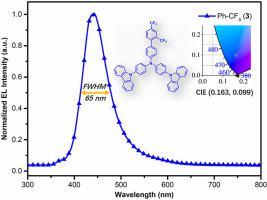Dyes and Pigments ( IF 4.1 ) Pub Date : 2021-07-11 , DOI: 10.1016/j.dyepig.2021.109627 Longzhi Zhu 1, 2, 3 , Hongyang Zhang 2, 3 , Xiao Peng 1 , Miao Zhang 2, 3 , Feifan Zhou 1 , Shuming Chen 4 , Jun Song 1 , Junle Qu 1, 5 , Wai-Yeung Wong 2, 3

|
Three new donor-acceptor (D-A) chromophores decorated with bis(trifluoromethyl)-substituted phenyl group as acceptor and bis(4-(9H-carbazol-9-yl)phenyl)amine as donor unit, namely 1,4-naphthyl-CF3 (1), 1,5-naphthyl-CF3 (2) and Ph-CF3 (3), were designed and synthesized. Their photophysical and electrochemical characteristics, and corresponding theoretical calculations were investigated. They showed blue emissions with high photoluminescence quantum yields (PLQY). Doped organic light-emitting diodes (OLEDs) based on them were fabricated, which exhibited strong blue electroluminescence with emission peaks at 453, 446 and 440 nm and full width at half maximum (FWHM) of 69, 65 and 65 nm, respectively. Their Commission International del'Eclairage (CIE) coordinates correspond to (0.169, 0.158), (0.176, 0.134) and (0.163, 0.099). Besides, the maximum current efficiencies (CEs) of 2.8, 5.0 and 4.9 cd A−1; power efficiencies (PEs) of 2.9, 5.4 and 5.2 lm W−1; external quantum efficiencies (EQEs) of 2.3, 2.3 and 3.4% were achieved for 1,4-naphthyl-CF3 (1), 1,5-naphthyl-CF3 (2) and Ph-CF3 (3) doped devices D1, D2 and D3, respectively. This study clearly showed that the optoelectronic properties of these organic small molecules can be regulated by rational design of molecular structures, and their emission wavelengths could be finely tuned within the blue region.
中文翻译:

使用 CF 3取代的双((咔唑-9-基)苯基)胺作为发射体的窄带宽蓝色 OLED :发色团中供体和受体之间接头的结构调节
三个新的供体 - 受体(DA)发色团装饰有双(三氟甲基)取代的苯基作为受体和双(4-(9 H -咔唑-9-基)苯基)胺作为供体单元,即1,4-萘基- CF 3 ( 1 )、1,5-萘基-CF 3 ( 2 )和Ph-CF 3 ( 3)),被设计和合成。研究了它们的光物理和电化学特性以及相应的理论计算。它们显示出具有高光致发光量子产率 (PLQY) 的蓝色发射。制造了基于它们的掺杂有机发光二极管 (OLED),其表现出强烈的蓝色电致发光,发射峰分别位于 453、446 和 440 nm,半峰全宽 (FWHM) 分别为 69、65 和 65 nm。他们的 Commission International del'Eclairage (CIE) 坐标对应于 (0.169, 0.158)、(0.176, 0.134) 和 (0.163, 0.099)。此外,最大电流效率 (CE) 为 2.8、5.0 和 4.9 cd A -1;功率效率 (PE) 为 2.9、5.4 和 5.2 lm W -1; 对于 1,4-萘基-CF 3 ( 1 )、1,5-萘基-CF 3 ( 2 ) 和 Ph-CF 3 ( 3 ) 掺杂器件 D1实现了 2.3、2.3 和 3.4% 的外部量子效率 (EQE) ,D2 和 D3,分别。这项研究清楚地表明,这些有机小分子的光电特性可以通过分子结构的合理设计来调节,并且它们的发射波长可以在蓝色区域内进行微调。































 京公网安备 11010802027423号
京公网安备 11010802027423号